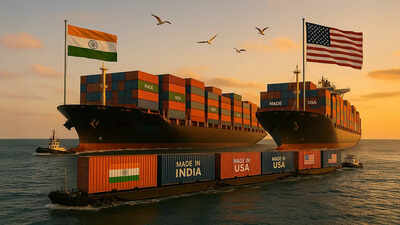India-US trade deal update: Intense trade discussions between India and the US continue for the sixth consecutive day on Tuesday in Washington, as negotiations reach a critical phase with New Delhi seeking improved market accessibility for its workforce-intensive products, according to an official.The Indian delegation, led by special secretary Rajesh Agrawal from the Department of Commerce, is conducting negotiations in Washington regarding an interim trade agreement with the US.The Indian officials have extended their stay beyond the initial two-day schedule, which began on June 26.
What’s the rush for an India-US trade deal?
- These discussions hold significance as US President Donald Trump’s reciprocal tariffs suspension deadline approaches on July 9. Both countries aim to conclude negotiations before this date, the official indicated to PTI.
- “If the proposed trade talks fail, the 26 per cent tariffs will come into force again,” the official added.
- On April 2, the United States levied an extra 26 per cent reciprocal duty on Indian merchandise but deferred it for 90 days. The existing 10 per cent baseline tariff by America continues. India seeks complete relief from the supplementary 26 per cent duty.
- Both nations are striving to finalise discussions for the initial phase of the bilateral trade agreement (BTA) by autumn (September-October) this year. The agreement targets increasing two-way trade to $500 billion by 2030, up from the present $191 billion.
- The countries are working towards establishing an interim trade arrangement before implementing the first tranche.
- American officials visited from June 5 to June 11 for discussions. Future negotiations will proceed through both online and in-person meetings.
India Hardens Stance
India has taken a firm stance regarding duty concessions on US agricultural products. At the same time it is requesting duty reductions for its workforce-intensive sectors including textiles, engineering, leather, gems and jewellery.The United States wants duty reductions in agricultural and dairy sectors. However, India finds it problematic to grant these concessions as Indian agricultural workers operate small farms for basic sustenance, making these sectors politically delicate.India has consistently maintained a closed dairy sector across all its free trade agreements with international partners.The United States seeks duty reductions on industrial products, vehicles (particularly electric vehicles), wines, petrochemical items, dairy products, and agricultural goods including apples, tree nuts, and genetically modified crops.India aims to secure tariff reductions in sectors employing large workforces, including textiles, gems and jewellery, leather products, apparel, plastics, chemicals, shrimp, oil seeds, grapes and bananas within the framework of the proposed trade agreement.According to the Global Trade Research Initiative (GTRI), as negotiations for the agreement reach a crucial phase, India is strongly advocating for complete tariff elimination on exports that generate substantial employment, including garments, footwear, carpets, and leather goods.Also Read | ‘If India removes tariffs, then cheap…’: GTRI warns of huge risks to lowering duties on US farm goods amidst trade deal talks; here’s what could go wrongGTRI Founder Ajay Srivastava noted that without such tariff relief, the agreement would be difficult to justify domestically. He observed that Washington seems reluctant to eliminate high MFN (most favoured nation) tariffs or country-specific duties.Current proposals suggest Indian products could incur a 10 per cent additional charge above MFN rates, which would reduce their competitive edge and effectively nullify market access benefits.
India-US Trade Numbers
India’s merchandise exports to the United States increased by 21.78 per cent reaching $17.25 billion during April-May of the current fiscal year, whilst imports grew by 25.8 per cent to $8.87 billion.Merchandise exports to the United States increased to $86.5 billion in FY25, showing an 11.6 per cent growth from $77.5 billion in FY24.The majority of this trade consists of industrial products, with labour-intensive exports comprising a considerable portion.“However, without fast-track trade authority, Washington is unable to cut its MFN (Most Favoured Nation) tariffs across the board. Worse still, US appears to be in no mood to exempt country specific tariffs and just bring it down to 10 per cent,” Srivastava said.The potential impact of this situation poses significant concerns, particularly affecting labour-intensive industries that generated more than $14.3 billion in exports from India to the US in FY25.The affected sectors include various industries, including garments ($5.33 billion), textiles and carpets ($2.38 billion), made-ups and worn clothing ($2.95 billion), leather ($795 million), footwear ($461 million), ceramics and stoneware ($1.55 billion), and wood and paper articles ($823 million).Also Read | Remittances at a record high! Indian diaspora sends home $135.46 billion; inflows more than double in eight yearsThese industries, primarily consisting of small and medium-sized businesses, serve as significant employment sources in Indian states including Uttar Pradesh, Tamil Nadu, Gujarat, and West Bengal. However, they encounter substantial US tariffs, particularly in garments and footwear sectors, with rates typically between 8 and 20 per cent.India’s position remains firm regarding the removal of all tariffs by the US, encompassing both MFN and country-specific duties on labour-intensive products across high and medium categories.These sectors provide employment to millions of people, especially in rural and semi-urban areas, and are vital for India’s objectives of employment generation, MSME development, and increasing women’s participation in the economy.“Without meaningful tariff relief for these products, Indian negotiators warn, the FTA will be viewed as lopsided and politically untenable,” Srivastava said.



